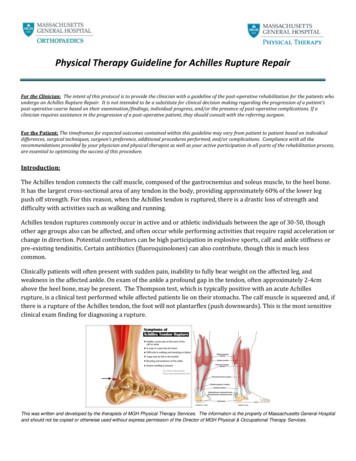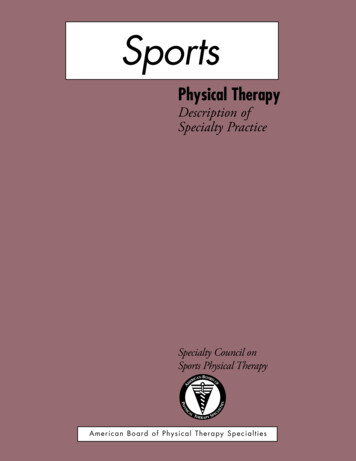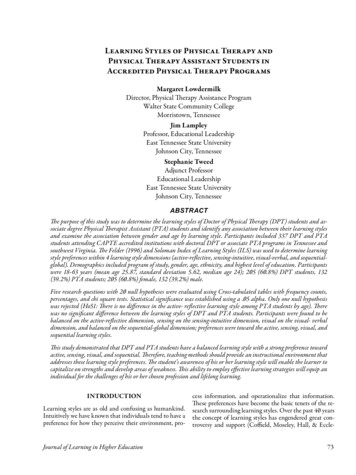
Transcription
Physical Therapy Guideline for Achilles Rupture RepairFor the Clinician: The intent of this protocol is to provide the clinician with a guideline of the post-operative rehabilitation for the patients whoundergo an Achilles Rupture Repair. It is not intended to be a substitute for clinical decision making regarding the progression of a patient’spost-operative course based on their examination/findings, individual progress, and/or the presence of post-operative complications. If aclinician requires assistance in the progression of a post-operative patient, they should consult with the referring surgeon.For the Patient: The timeframes for expected outcomes contained within this guideline may vary from patient to patient based on individualdifferences, surgical techniques, surgeon’s preference, additional procedures performed, and/or complications. Compliance with all therecommendations provided by your physician and physical therapist as well as your active participation in all parts of the rehabilitation process,are essential to optimizing the success of this procedure.Introduction:The Achilles tendon connects the calf muscle, composed of the gastrocnemius and soleus muscle, to the heel bone.It has the largest cross-sectional area of any tendon in the body, providing approximately 60% of the lower legpush off strength. For this reason, when the Achilles tendon is ruptured, there is a drastic loss of strength anddifficulty with activities such as walking and running.Achilles tendon ruptures commonly occur in active and or athletic individuals between the age of 30-50, thoughother age groups also can be affected, and often occur while performing activities that require rapid acceleration orchange in direction. Potential contributors can be high participation in explosive sports, calf and ankle stiffness orpre-existing tendinitis. Certain antibiotics (fluoroquinolones) can also contribute, though this is much lesscommon.Clinically patients will often present with sudden pain, inability to fully bear weight on the affected leg, andweakness in the affected ankle. On exam of the ankle a profound gap in the tendon, often approximately 2-4cmabove the heel bone, may be present. The Thompson test, which is typically positive with an acute Achillesrupture, is a clinical test performed while affected patients lie on their stomachs. The calf muscle is squeezed and, ifthere is a rupture of the Achilles tendon, the foot will not plantarflex (push downwards). This is the most sensitiveclinical exam finding for diagnosing a rupture.This was written and developed by the therapists of MGH Physical Therapy Services. The information is the property of Massachusetts General Hospitaland should not be copied or otherwise used without express permission of the Director of MGH Physical & Occupational Therapy Services.
Physical Therapy Guideline for Achilles Rupture RepairTreatment:Acute Achilles tendon ruptures can be treated both with and without surgery, each with its own risks and benefits.Historically the tradeoffs were between a much higher rate of re-rupture of the tendon with nonoperativemanagement (approximately 1 in 7 patients) versus the risk of wound complication with surgery. More recentliterature suggests that patients undergoing nonoperative management can effectively decrease with their rerupture rate with a more proactive functional rehabilitation protocol. Some studies suggest that this rate may nowbe similar among operative and non-operative patients (3-4%), but others still underscore a somewhat higher rerupture rate with non-operative management. The benefit of surgery may be higher long-term calf strength,though even this is debated in various studies.Non-operative Treatment:Non-operative management with functional rehabilitation protocols typically includes a brief, two-week period ofimmobilization of the foot in a pointed (plantarflexed) position in a splint, followed by a transition to an Achillesboot with multiple wedges keeping the foot pointing downwards. Progressively, gentle motion is allowed withprogressive weight bearing, though different providers and protocols vary in how quickly they allow both weightbearing and elevation of the toes upwards. The goal is to allow the tendon to heal and gradually pull the calfdownwards, all the while limiting any stretching of the healing tendon itself.Operative Treatment:Surgical treatment of the Achilles tendon typically involved making an incision, opening up the skin and identifyingboth ends of the torn tendon. Once identified, the two ends are approximated and sutured together to restorecontinuity of the tendon. Patients are similarly placed in a splint and subsequently an Achilles boot with heel liftswith progressive advancement of weight bearing and motion. Again, protocols vary among providers but, similar tononoperative management, the goal is to allow the tendon to heal and gradually pull the calf downwards, whilelimiting stretching of the healing tendon itself.This was written and developed by the therapists of MGH Physical Therapy Services. The information is the property of Massachusetts General Hospitaland should not be copied or otherwise used without express permission of the Director of MGH Physical & Occupational Therapy Services.
Physical Therapy Guideline for Achilles Rupture RepairPhaseRestrictions andPrecautionsPre-operativeStage 10-2 weeks-Non-weight-bearing (NWB) insplint at all timesPhysical Therapy TreatmentGoals-Instruct with use of assistive devicebased on gait assessment, non-weightbearing (NWB) on affected side-Demonstrate safe ambulation withassistive device NWB-Edema management-Manage swelling-Gait training and safety (emphasizeprecautions with weight bearing)-Demonstrate safe ambulation withassistive device NWB-Education/modifications for ADLs-Able to maintain NWB withtransfers and stairs-Able to maintain NWB withtransfers and stairs-Perform activities of daily living(ADLs) in a modified independentmanner or with minimal assistanceStage 22-4 weeks-Non-weight bearing (NWB) withassistive device in Achilles boot orcontrolled ankle motion (CAM)boot with three (1 inch) heelwedges-No active or passivedorsiflexion (DF) past 5degrees below neutral-Exercises and hands-on techniques (bythe PT) for foot and ankle range ofmotion into plantar flexion (PF),dorsiflexion (DF) to 5 degrees belowneutral only, inversion/eversionperformed in no more than 5 degreesbelow neutral dorsiflexion-Modalities and patient education tocontrol swelling-Manage swelling-Increase range of motion of footand ankle while maintaining DFprecautions-Minimize the loss of strength in thecore, hips, and knees-Independence with home exerciseprogram to be performed daily-Once incision healed, scarmobilization/massage-Open chain strengthening for core, hips,knees (maintain precautions) in boot-NWB fitness/cardiovascular exercises(i.e. bicycle with one leg)This was written and developed by the therapists of MGH Physical Therapy Services. The information is the property of Massachusetts General Hospitaland should not be copied or otherwise used without express permission of the Director of MGH Physical & Occupational Therapy Services.
Physical Therapy Guideline for Achilles Rupture RepairPhaseRestrictions and PrecautionsPhysical Therapy TreatmentGoalsStage 3-Begin partial progressive weightbearing with assistive device andAchilles boot with three (1 inch)heel wedges; slowly increaseweight bearing by 25-50 lbs everyweek until full weight bearingthrough the involved limb-Continue ankle A/PROM exercises andhands-on techniques. At 4 weeks,progress to DF to neutral (0 degrees).At 6 weeks, may allow DF past neutral.-Full range of motion foot and anklein all planes (except DF must remainbelow neutral until 6 weeks post-op)-As dorsiflexion ROM improves,progress to only two (1 inch)heel wedges when able to get heeldown in boot comfortably withpartial progressive weight bearing(usually by post-op week 6)-Foot/ankle strengthening exercises –maintain precautions4-8 weeks-Utilize “Even Up” shoe leveler tobe placed on shoe of uninvolvedside to level shoe with boot height(unless pre-existing balancedeficits)-No active or passivedorsiflexion past neutral (0degrees) until 6 weeks post-opStage 48-12 weeks-At 8-10 weeks: Remove one heelwedge from the boot so that thereis only one wedge remaining inboot.-At 10-12 weeks: Remove finalheel wedge from the boot.-Continue to wear the boot withwedge(s) until 12 weeks postoperatively for communityambulation-No weight bearing stretching ofgastrocnemius or soleus to avoidoverlengthening of the tendon-May begin stationary bike insneaker with heel lift – no outdoorcycling-NWB stretching of proximal lowerextremity muscles (not calf)-Joint mobilization techniques by the PTto restore motion of the foot and ankle-Restore proximal strength/controlof the core, hip and knee whereapplicable-Full weight bearing in Achilles bootwith two (inch heel wedges) withoutassistive device by post-op week 8-Gait training to ensure safety and tonormalize pattern with assistive deviceand “Even Up”-Activity progression per PT guidance-Fitness/cardiovascular – progress tostationary bike or Nu-step with both legs(in boot)-Gait training to wean off the assistivedevices and normalize gait in the boot-Functional activities, closed kinetic chainexercises in boot with heel lifts and “EvenUp” once WBAT in boot without assistivedevice-At 8-10 weeks: Begin weight shifting insneaker with heel lift (1 cm) supervised inclinic and as part of home exerciseprogram (may still be ambulating withboot in the community)-Full DF active range of motion-Full strength of lower extremitymuscles (except calf)-Gradually return to regularfunctional activities (except sportsand weight bearing fitness activities)if ROM, strength, and gait goals havebeen met-Improved gait pattern on all surfacesin boot without heel wedges withoutassistive device-Progress to bilateral weight bearing andsingle leg exercises in sneaker with heellift (1 cm) supervised in clinic and as partof home exercise program (may still beambulating with boot in the community)This was written and developed by the therapists of MGH Physical Therapy Services. The information is the property of Massachusetts General Hospitaland should not be copied or otherwise used without express permission of the Director of MGH Physical & Occupational Therapy Services.
Physical Therapy Guideline for Achilles Rupture RepairPhaseRestrictions and PrecautionsPhysical Therapy TreatmentGoalsStage 5-If not yet out of boot forcommunity ambulation, wean outof the boot to a sneaker with heellift (1 cm)-Once single leg closed chain activities aremastered in sneaker, progress to varyingsurfaces-Normalize gait pattern in sneakerswith one heel lift (1 cm)12-14 weeks-Full strength and motor control ofbilateral lower extremities-Once gait normalized, weanremaining heel lift from sneakerper patient tolerance-Fitness/Cardiovascular exercises toinclude the addition of the following astolerated: e.g. elliptical, walking ontreadmill, Stairmaster-Avoid high impact/pivoting – norunning-Advance functional training to includesports specific movement patterns-Gradual return to minimal or lowimpact sports (cycling, rowing,swimming, Stairmaster, elliptical)-Begin bilateral plyometric progressionand progress to unilateral plyometrics-Ambulating with normal gait patternin sneakers without heel lift-Sport specific training and conditioning(progress to high impact if applicable astolerated once cleared by surgeon)-Gradual return to activities withmulti-planar movements on unevenoutdoor surfaces (hiking)-Good balance and proprioception ofbilateral lower extremities-No weight bearing stretching ofgastrocnemius or soleusStage 614-24 weeks-No running or pivoting until 6months post-operative/nonoperative-At 6 months: Gradual return to highimpact sports that include jogging,running, and jumping once cleared bysurgeon and lower extremityfunctional testing for return to sportsis at least 90% of the uninvolved sideThis was written and developed by the therapists of MGH Physical Therapy Services. The information is the property of Massachusetts General Hospitaland should not be copied or otherwise used without express permission of the Director of MGH Physical & Occupational Therapy Services.
Physical Therapy Guideline for Achilles Rupture RepairIf you have any questions or concerns related to the content of these rehabilitation guidelines, please contact:MGH Physical and Occupational Therapy Services (Mass General Waltham)781-487-3800Website: http://www.massgeneral.org/physical-therapy/MGH Orthopedics Foot and Ankle617-724-9338Website: nces:Chiodo, Christopher P., MD et al. “American Academy of Orthopedic Surgeons Clinical Practice Guideline on Treatment ofAchilles Tendon Rupture.” JBJS. Volume 92, Issue 14 October 2010: 2466-2468.Post-Operative/Non-Operative Achilles Rupture Protocol - Dr. Christopher DiGiovanni, MDAchilles Tendon Rupture Rehabilitation Protocol - Dr. Daniel Guss, MD, is was written and developed by the therapists of MGH Physical Therapy Services. The information is the property of Massachusetts General Hospitaland should not be copied or otherwise used without express permission of the Director of MGH Physical & Occupational Therapy Services.
Physical Therapy Guideline for Achilles Rupture Repair. This was written and developed by the therapists of MGH Physical Therapy Services. The information is the property of Massachusetts General Hospital and should not be copied or otherwise used without express permission of the Director of MGH Physical & Occupational Therapy Services.










